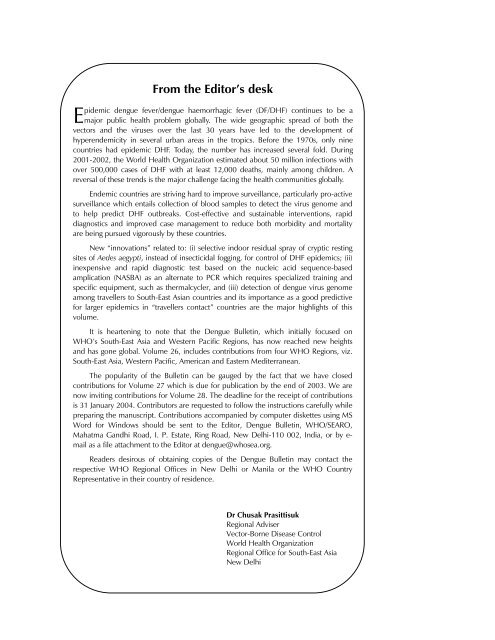Dengue Bulletin
Dengue Bulletin
Dengue Bulletin
- TAGS
- dengue
- bulletin
- 203.90.70.117
You also want an ePaper? Increase the reach of your titles
YUMPU automatically turns print PDFs into web optimized ePapers that Google loves.
E<br />
From the Editor’s desk<br />
pidemic dengue fever/dengue haemorrhagic fever (DF/DHF) continues to be a<br />
major public health problem globally. The wide geographic spread of both the<br />
vectors and the viruses over the last 30 years have led to the development of<br />
hyperendemicity in several urban areas in the tropics. Before the 1970s, only nine<br />
countries had epidemic DHF. Today, the number has increased several fold. During<br />
2001-2002, the World Health Organization estimated about 50 million infections with<br />
over 500,000 cases of DHF with at least 12,000 deaths, mainly among children. A<br />
reversal of these trends is the major challenge facing the health communities globally.<br />
Endemic countries are striving hard to improve surveillance, particularly pro-active<br />
surveillance which entails collection of blood samples to detect the virus genome and<br />
to help predict DHF outbreaks. Cost-effective and sustainable interventions, rapid<br />
diagnostics and improved case management to reduce both morbidity and mortality<br />
are being pursued vigorously by these countries.<br />
New “innovations” related to: (i) selective indoor residual spray of cryptic resting<br />
sites of Aedes aegypti, instead of insecticidal fogging, for control of DHF epidemics; (ii)<br />
inexpensive and rapid diagnostic test based on the nucleic acid sequence-based<br />
amplication (NASBA) as an alternate to PCR which requires specialized training and<br />
specific equipment, such as thermalcycler, and (iii) detection of dengue virus genome<br />
among travellers to South-East Asian countries and its importance as a good predictive<br />
for larger epidemics in “travellers contact” countries are the major highlights of this<br />
volume.<br />
It is heartening to note that the <strong>Dengue</strong> <strong>Bulletin</strong>, which initially focused on<br />
WHO’s South-East Asia and Western Pacific Regions, has now reached new heights<br />
and has gone global. Volume 26, includes contributions from four WHO Regions, viz.<br />
South-East Asia, Western Pacific, American and Eastern Mediterranean.<br />
The popularity of the <strong>Bulletin</strong> can be gauged by the fact that we have closed<br />
contributions for Volume 27 which is due for publication by the end of 2003. We are<br />
now inviting contributions for Volume 28. The deadline for the receipt of contributions<br />
is 31 January 2004. Contributors are requested to follow the instructions carefully while<br />
preparing the manuscript. Contributions accompanied by computer diskettes using MS<br />
Word for Windows should be sent to the Editor, <strong>Dengue</strong> <strong>Bulletin</strong>, WHO/SEARO,<br />
Mahatma Gandhi Road, I. P. Estate, Ring Road, New Delhi-110 002, India, or by email<br />
as a file attachment to the Editor at dengue@whosea.org.<br />
Readers desirous of obtaining copies of the <strong>Dengue</strong> <strong>Bulletin</strong> may contact the<br />
respective WHO Regional Offices in New Delhi or Manila or the WHO Country<br />
Representative in their country of residence.<br />
Dr Chusak Prasittisuk<br />
Regional Adviser<br />
Vector-Borne Disease Control<br />
World Health Organization<br />
Regional Office for South-East Asia<br />
New Delhi









